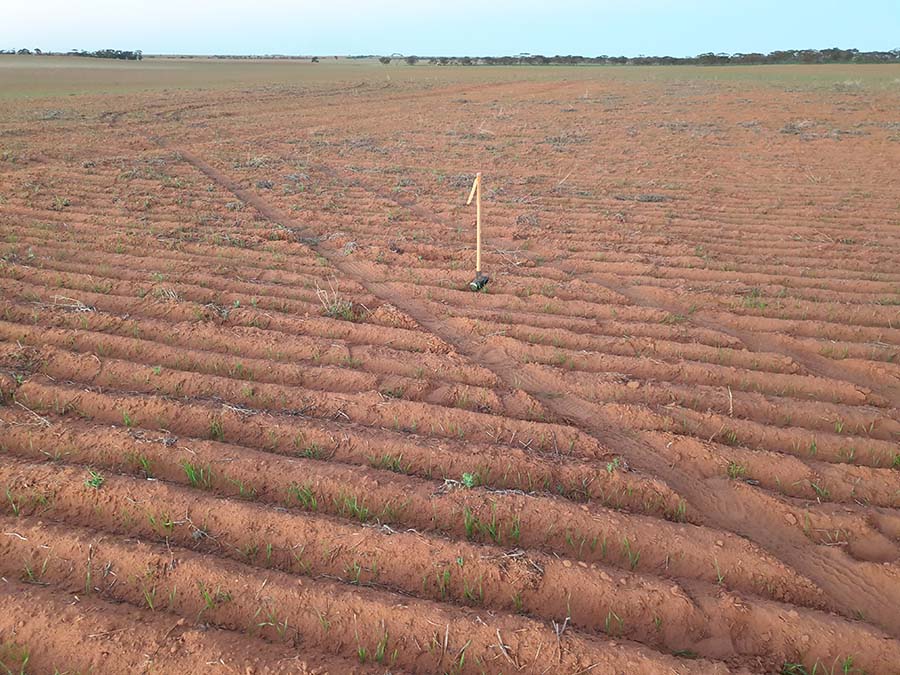Snapshot
Grower: Chris and Leanne Hunt
Location: Northern Victorian Mallee
Farm size: 5,500 Ha (Millewa region)
Enterprise: Mixed farming
Growing season rainfall: 280mm annual (171mm GSR)
Soil type: Soils range from loamy sand rises to good sandy loam flats interspersed with less productive marly sodic flats
Cropping program: 50% cereal and 40% legume
Seeding system: No-till farming, Flexicoil 820 (modified chisel plough, with paired row boots). Strategically varies AB lines by 10-15% between seasons.
Chris and Leanne Hunt farm 5500ha with Chris’s father and brothers’ families in the Millewa region of the northern Victorian Mallee. Average rainfall is approximately 280mm, with 171mm on average during the growing season. Like many Mallee farmers, the Hunt’s manage a range of soil types, from loamy sand rises to sandy loam flats interspersed with less productive marly sodic flats. These require careful management as they are prone to baring out and fining up and easily blow during dry periods.
This mixed farming operation aims to sow most paddocks each year, with the rotation being 50% cereal (wheat and barley) and 40% legume (vetch for hay, grain or grazing and field peas; with chickpeas in recent years). They run 1000 merino ewes crossed with Poll Dorset and White Suffolk rams, producing sucker lambs for market.
As no-till farmers, they use a Flexicoil 820, a modified chisel plough with paired row root boots, and focus on achieving adequate summer soil cover each year and closely monitor grazing paddocks. To improve the distribution of header rows and lessen wheel track impacts across the farm, Chris also varies his sowing and harvesting AB lines by 10-15% between seasons and alternates his SP boomspray runs.
Effective livestock grazing strategies – the key to mitigating wind erosion risks
Soil protection through break crop years is paramount.
Good stubble is considered crucial for the Hunt’s. With a mixed farming system and grazing across a range of soil types, the Hunt’s require the flexibility to remove stock while 50% anchored ground cover remains. Stock containment areas and feed on hand have proven vital components of their strategy. Careful stock management is critical for intensive cropping in these environments.
The Hunt’s have their own hay cutting and baling equipment, supporting their business to be responsive to feed supply needs. When hay feed reserves are short, barley straw will be baled from better areas of paddocks if required. Straw is also baled and stored in good years for use within confinement feeding yards, providing excellent cover, shelter and roughage for stock. They consider this far safer than allowing paddock grazing where the poor patches bare out and trigger significant erosion.
“Using our own hay and straw is much preferred over the risk of bringing unwanted weeds onto your property from outside sources,” Chris says.
There’s value in vetch
The Hunt’s find their legume phase is vital in optimising cereal outcomes within their rotation, but it also presents the highest risk. Vetch has proven broadly adapted, provides high nitrogen fixation levels compared to other pulses and is versatile for grazing, hay and grain production, allowing greater flexibility depending on seasonal conditions. It is an excellent feed source for use within the containment areas.
The Hunt’s have found that vetch produces the greatest biomass when dry sown early. This is typically before the seasonal outlook is clear. A sowing rate of 30kg/ha with barley at 10kg/ha has proven optimal for establishment and also provides sufficient soil protection, particularly in more vulnerable areas. Depending on seasonal conditions, the barley can then be sprayed out if required.
Harnessing pulse opportunities and grazing pulse stubbles
Chickpeas also have a place in the Hunt’s program if there is subsoil moisture and a seeding break to the season. In dry seasons, field peas are preferred as they have better drought tolerance and greater background soil inoculum to handle these conditions. In these years, rolling is also delayed as rolled paddocks are more prone to sweeping winds than paddocks left with press wheel ridges.
Grazing on legume stubbles to pick up the remaining grain is cautiously undertaken. Field pea stubbles must be carefully monitored, as plants are easily dislodged from the soil, forming balls that catch eroding sand and make paddocks uneven.
When coming out of tough springs and when there is inadequate stubble cover, the Hunt’s will broadcast cereal rye across vulnerable areas prior to sowing pulses. This can either be removed in-season or left to produce as much ground cover as possible in drought years.
![]()

Only 10% soil cover in May 2022 with no grazing, on both sandy rises and marly flats. Photo: Supplied
The need for this cereal straw protection in pulse years was proven when pea stubbles, showing a safe 50% soil cover in December 2021 (main image), were reduced to a very vulnerable 10% cover by May 2022 despite no grazing. The weak straw simply broke up and rotted away after a few summer rain storms.
Read: Proactive soil cover strategies within sustainable continuous cropping programs - including pulses.
Listen to the podcast: Soil preservation tactics in successive low rainfall seasons with Chris Hunt.

























































